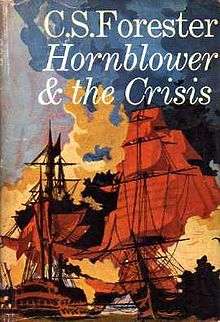Hornblower and the Crisis
 First edition | |
| Author | C. S. Forester |
|---|---|
| Country | United Kingdom |
| Language | English |
| Series | Horatio Hornblower |
| Genre | Historical novel |
| Publisher | Michael Joseph |
Publication date | 1967 |
| Media type | Hardcover & paperback |
| Pages | 158 pp |
| OCLC | 16499816 |
| Preceded by |
Hornblower and the Hotspur (1962) |
| Followed by | Hornblower and the Atropos |
Hornblower and the Crisis is a 1967 historical novel by C. S. Forester. It forms part of the Horatio Hornblower series, and as a result of C.S. Forester's death in 1966, it was left unfinished. There is a one-page summary of the last several chapters of the book found on the final page, taken from notes left behind from the author. It was the eleventh and last book of the series to be published, but it is fourth in chronological sequence.
Several other writers have written conclusions, notable efforts being that of Bob Smith, member of the C S Forester Society, published in 2010 and The Jamaican Affair by John Mahon, published in 2012 as an ebook by eNetPress.
Plot summary
Hornblower has just finished his tour blockading Brest in command of the Royal Navy sloop Hotspur. As he travels back to England for his next assignment, he is asked to participate in the court martial of Hotspur's new captain and officers. Hotspur ran aground and was lost the day after Hornblower turned over command.
Following the court martial, the officers travel back to England with Hornblower. On their way, they are pursued by a French brig, which they engage and disable. During the battle, Hornblower boards the brig and finds important papers in the French captain's quarters. Back in England, he travels to the Admiralty with the documents. He arrives at the same time as the disappointing news that the French fleet under Admiral Pierre-Charles Villeneuve has escaped into Ferrol, Spain after an indecisive engagement.
Hornblower presents a daring plan to the Secretary of the Navy, to send false orders to Villeneuve, made possible because the papers brought by Hornblower include an example of Napoleon Bonaparte's new signature. The orders are to draw Villeneuve out of a safe harbour and into a decisive engagement with Admiral Nelson.
The unfinished book stops at the point where Hornblower is persuaded to attempt the mission himself. Notes left by C.S. Forester indicate that Hornblower would carry out the mission accompanied by South American revolutionary Francisco de Miranda, with Hornblower posing as his servant. They deliver the false orders to Villeneuve without arousing suspicion, prompting him to take his fleet to sea; this ultimately leads the destruction of the Franco–Spanish fleet at the Battle of Trafalgar.
This book also includes two short-stories, "Hornblower and the Widow McCool" (a.k.a. "Hornblower’s Temptation"), set early in Hornblower's career, and "The Last Encounter", set in 1848 when he is living on his country estate in old age and retirement.